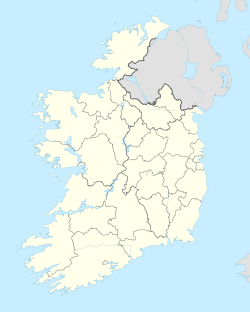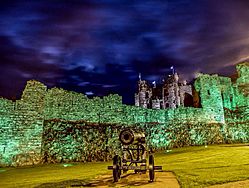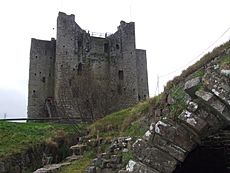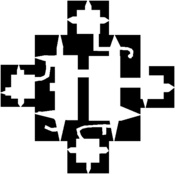Trim Castle facts for kids
Quick facts for kids Trim Castle |
|
|---|---|
| Trim, County Meath, Ireland | |
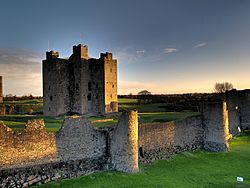
The main tower (keep) and the protective curtain walls of Trim Castle.
|
|
| Coordinates | 53°33′18″N 6°47′23″W / 53.555°N 6.7897°W |
| Type | Medieval castle |
| Site information | |
| Owner | Currently the Irish Government through the Office of Public Works |
| Condition | Ruin |
| Site history | |
| Built | from the 12th century |
| Built by | Hugh de Lacy (keep) |
| In use | Open to public |
| Official name | Trim Castle |
| Reference no. | 514 |
Trim Castle (in Irish: Caisleán Bhaile Átha Troim) is a huge medieval castle in Trim, County Meath, Ireland. It sits on the south bank of the River Boyne. Covering an area of 30,000 square meters, it is the largest Norman castle in Ireland.
The castle was built over 30 years by a powerful Norman lord named Hugh de Lacy and his son, Walter. It served as the main headquarters for their territory, the Lordship of Meath. Today, the Irish Government owns the castle. A state agency called the Office of Public Works (OPW) takes care of it.
Trim Castle is also an official National Monument of Ireland, which means it is a protected historical site.
Contents
The Story of Trim Castle
The First Builders: The de Lacys
In 1172, King Henry II of England gave the land of Meath to one of his most trusted knights, Hugh de Lacy. To protect his new territory, de Lacy built a massive castle on a hill overlooking a crossing point on the River Boyne. This was a smart location because boats could travel up the river from the Irish Sea, making it an important spot for trade and defense.
De Lacy's first castle was made of wood. It was a "ringwork" castle, which means it had a large circular fort protected by a strong double fence and a deep ditch.
When de Lacy had to leave Ireland, he put his lieutenant, Hugh Tyrrel, in charge. Soon after, the castle was attacked and burned by the forces of the Irish High King, Ruaidrí Ua Conchobair. Tyrrel had to escape. However, the Irish king's forces left quickly, and de Lacy returned to rebuild the castle in 1173, this time using stone.
After Hugh de Lacy died in 1186, his son Walter took over. He continued building, and the strong stone castle we see today was mostly finished by the 1220s.
New Owners and Royal Connections
After Walter de Lacy died in 1241, the castle passed to his granddaughter, Maud de Lacy. She married a French lord named Geoffrey de Geneville. They added a new great hall and other buildings to the castle.
Later, the castle was inherited by the Mortimer family through marriage. Roger Mortimer was one of England's most powerful nobles. The Mortimers held the castle until 1425.
The castle then passed to Richard of York. His son, Edward IV, became King of England. During the 15th century, Trim Castle was very important. The Irish Parliament met there seven times, and it even had a mint for making coins. It was the administrative center for the region and marked the northern border of an area controlled by the English called The Pale.
Later History and Restoration
Over time, the castle fell into disrepair. It was briefly strengthened during wars in the 1640s. In 1649, after a nearby town was attacked by the army of Oliver Cromwell, the soldiers at Trim Castle fled. Cromwell's army then occupied it.
After more wars in the 1680s, the castle was given to the Wellesley family. One famous member of this family was Arthur Wellesley, 1st Duke of Wellington, who defeated Napoleon at the Battle of Waterloo. He later sold the castle.
The castle was eventually owned by the Dunsany family, who held it until 1993. They sold the castle and its lands to the Irish State so it could be preserved for everyone to enjoy. The Office of Public Works (OPW) then began a major restoration project to conserve the castle and make it safe for visitors. The castle reopened to the public in 2000.
What the Castle Looks Like
Trim Castle is the largest Norman castle in Ireland. Its most impressive feature is the central three-story tower, called a keep. The keep has a unique cross-shaped design with twenty corners, which made it very strong and easy to defend.
The castle is surrounded by a massive outer wall, called a curtain wall. This wall has several towers and two main gates.
- The West Gate is the oldest, dating back to the 1170s.
- The Dublin Gate on the south side has a round tower and an outer defense called a barbican. This design was one of the first of its kind in Ireland.
Inside the walls, archaeologists have found the remains of many buildings. These include:
- A huge Great Hall from the 13th century, where banquets and meetings were held.
- Stables for horses.
- A building that might have been the mint, where coins were made.
- Several lime kilns, which were used to create mortar for building the stone walls.
Visiting Trim Castle
The Office of Public Works manages Trim Castle. Visitors can pay a fee to explore the castle grounds on their own.
To go inside the main keep, you must take a guided tour, which also has a fee. The tour guides explain the castle's history and show you its amazing features up close. During the winter, the castle is usually only open on weekends and holidays.
See also
 In Spanish: Castillo de Trim para niños
In Spanish: Castillo de Trim para niños
Images for kids


